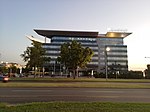The Socialist Federal Republic of Yugoslavia (SFRY), commonly referred to as SFR Yugoslavia or simply as Yugoslavia, was a country in Central and Southeast Europe. It emerged in 1945, following World War II, and lasted until 1992, with the breakup of Yugoslavia occurring as a consequence of the Yugoslav Wars. Spanning an area of 255,804 square kilometres (98,766 sq mi) in the Balkans, Yugoslavia was bordered by the Adriatic Sea and Italy to the west, by Austria and Hungary to the north, by Bulgaria and Romania to the east, and by Albania and Greece to the south. It was a one-party socialist state and federation governed by the League of Communists of Yugoslavia, and had six constituent republics: Bosnia and Herzegovina, Croatia, Macedonia, Montenegro, Serbia, and Slovenia. Within Serbia was the Yugoslav capital city of Belgrade as well as two autonomous Yugoslav provinces: Kosovo and Vojvodina.
The SFR Yugoslavia traces its origins to 26 November 1942, when the Anti-Fascist Council for the National Liberation of Yugoslavia was formed during World War II to resist Axis occupation of the Kingdom of Yugoslavia. Following the country's liberation, King Peter II was deposed, the monarchy was ended, and on 29 November 1945, the Federal People's Republic of Yugoslavia was proclaimed. Led by Josip Broz Tito, the new communist government sided with the Eastern Bloc at the beginning of the Cold War but pursued a policy of neutrality following the Tito–Stalin split in 1948; it became one of the founding members of the Non-Aligned Movement, and transitioned from a command economy to market-based socialism.
Following the death of Tito on 4 May 1980, the Yugoslav economy started to collapse, which increased unemployment and inflation. The economic crisis led to rising ethnic nationalism and political dissidence in the late 1980s and early 1990s. With the fall of communism in Eastern Europe, efforts to transition into a confederation failed; the two wealthiest republics, Croatia and Slovenia, seceded and gained some international recognition in 1991. The federation dissolved along the borders of federated republics, hastened by the start of the Yugoslav Wars, and formally broke up on 27 April 1992. Two republics, Serbia and Montenegro, remained within a reconstituted state known as the Federal Republic of Yugoslavia, or FR Yugoslavia, but this state was not recognized internationally as the sole successor state to SFR Yugoslavia. "Former Yugoslavia" is now commonly used retrospectively.










